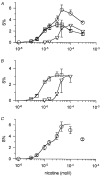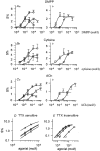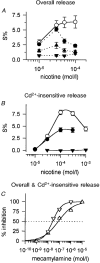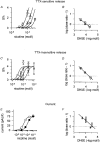Somatic and prejunctional nicotinic receptors in cultured rat sympathetic neurones show different agonist profiles
- PMID: 10200422
- PMCID: PMC2269288
- DOI: 10.1111/j.1469-7793.1999.0739u.x
Somatic and prejunctional nicotinic receptors in cultured rat sympathetic neurones show different agonist profiles
Abstract
1. The release of [3H]-noradrenaline ([3H]-NA) in response to nicotinic acetylcholine receptor (nAChR) agonists was compared with agonist-induced currents in cultured rat superior cervical ganglion (SCG) neurones. 2. [3H]-NA release in response to high concentrations of nicotinic agonists was reduced, but not fully inhibited, by the presence of either tetrodotoxin (TTX) or Cd2+ to block voltage-gated Na+ or Ca2+ channels, respectively. We used the component of transmitter release that remained in the presence of these substances (named TTX- or Cd2+-insensitive release) to pharmacologically characterize nAChRs in proximity to the sites of vesicular exocytosis (prejunctional receptors). Prejunctional nAChRs were activated by nicotinic agonists with a rank order of potency of dimethylphenylpiperazinium iodide (DMPP) > nicotine > cytisine > ACh, and with EC50 values ranging from 22 microM (DMPP) to 110 microM (ACh). 3. [3H]-NA release in response to low concentrations of nAChR agonists was fully inhibited by the presence of either TTX or Cd2+ (named TTX- or Cd2+-sensitive release). TTX-sensitive release was triggered by nicotinic agonists with a rank order of potency of DMPP > cytisine approximately nicotine approximately ACh, which due to its similarity to TTX-insensitive release indicates that it might also be triggered by prejunctional-type nAChRs. The EC50 values for TTX (Cd2+)-sensitive release were less than 10 microM for all four agonists. 4. By contrast to transmitter release, somatic nAChRs as seen by patch clamp recordings were most potently activated by cytisine, with a rank order of potency of cytisine > nicotine approximately DMPP > ACh. EC50 values for the induction of currents exceeded 20 microM for all four agonists. 5. The nicotinic antagonist mecamylamine potently inhibited all transmitter release in response to nicotine. alpha-Bungarotoxin (alpha-BuTX) was, on the other hand, without significant effect on nicotine-induced TTX-insensitive release. The competitive antagonist dihydro-beta-erythroidine (DHbetaE) caused rightward shifts of the dose-response curves for both TTX-sensitive and TTX-insensitive transmitter release as well as for currents in response to nicotine, with pA2 values ranging from 4.03 to 4.58. 6. Due to clear differences in the pharmacology of agonists we propose that nAChRs of distinct subunit composition are differentially targeted to somatic or axonal domains.
Figures







Similar articles
-
Selective deletion of the alpha5 subunit differentially affects somatic-dendritic versus axonally targeted nicotinic ACh receptors in mouse.J Physiol. 2005 Feb 15;563(Pt 1):119-37. doi: 10.1113/jphysiol.2004.075788. Epub 2004 Dec 20. J Physiol. 2005. PMID: 15611037 Free PMC article.
-
Pharmacological characterization of dopamine, norepinephrine and serotonin release in the rat prefrontal cortex by neuronal nicotinic acetylcholine receptor agonists.Brain Res. 2003 Nov 14;990(1-2):203-8. doi: 10.1016/s0006-8993(03)03532-7. Brain Res. 2003. PMID: 14568345
-
Release of [3H]-noradrenaline from rat hippocampal synaptosomes by nicotine: mediation by different nicotinic receptor subtypes from striatal [3H]-dopamine release.Br J Pharmacol. 1996 Feb;117(4):595-606. doi: 10.1111/j.1476-5381.1996.tb15232.x. Br J Pharmacol. 1996. PMID: 8646402 Free PMC article.
-
Modulatory role of presynaptic nicotinic receptors in synaptic and non-synaptic chemical communication in the central nervous system.Brain Res Brain Res Rev. 1999 Nov;30(3):219-35. doi: 10.1016/s0165-0173(99)00016-8. Brain Res Brain Res Rev. 1999. PMID: 10567725 Review.
-
Role of neuronal nicotinic receptors in the transmission and processing of information in neurons of the central nervous system.Pharmacol Biochem Behav. 2001 Dec;70(4):457-66. doi: 10.1016/s0091-3057(01)00700-6. Pharmacol Biochem Behav. 2001. PMID: 11796145 Review.
Cited by
-
Nicotinic regulation of energy homeostasis.Nicotine Tob Res. 2012 Nov;14(11):1270-90. doi: 10.1093/ntr/nts159. Epub 2012 Sep 18. Nicotine Tob Res. 2012. PMID: 22990212 Free PMC article. Review.
-
Autoimmune autonomic ganglionopathy: IgG effects on ganglionic acetylcholine receptor current.Neurology. 2007 May 29;68(22):1917-21. doi: 10.1212/01.wnl.0000263185.30294.61. Neurology. 2007. PMID: 17536048 Free PMC article.
-
Catecholamine outflow from mouse and rat brain slice preparations evoked by nicotinic acetylcholine receptor activation and electrical field stimulation.Br J Pharmacol. 2007 Jun;151(3):414-22. doi: 10.1038/sj.bjp.0707236. Epub 2007 Apr 2. Br J Pharmacol. 2007. PMID: 17401441 Free PMC article.
-
Human α3β4 neuronal nicotinic receptors show different stoichiometry if they are expressed in Xenopus oocytes or mammalian HEK293 cells.PLoS One. 2010 Oct 26;5(10):e13611. doi: 10.1371/journal.pone.0013611. PLoS One. 2010. PMID: 21049012 Free PMC article.
-
Biochemical and functional properties of distinct nicotinic acetylcholine receptors in the superior cervical ganglion of mice with targeted deletions of nAChR subunit genes.Eur J Neurosci. 2010 Mar;31(6):978-93. doi: 10.1111/j.1460-9568.2010.07133.x. Epub 2010 Mar 3. Eur J Neurosci. 2010. PMID: 20377613 Free PMC article.
References
-
- Boehm S, Huck S. α2-Adrenoreceptor-mediated inhibition of acetylcholine-induced noradrenaline release from rat sympathetic neurons: an action at voltage-gated Ca2+ channels. Neuroscience. 1995;69:221–231. - PubMed
-
- Boehm S, Huck S. Receptors controlling transmitter release from sympathetic neurons in vitro. Progress in Neurobiology. 1997;51:225–242. - PubMed
Publication types
MeSH terms
Substances
LinkOut - more resources
Full Text Sources
Miscellaneous

